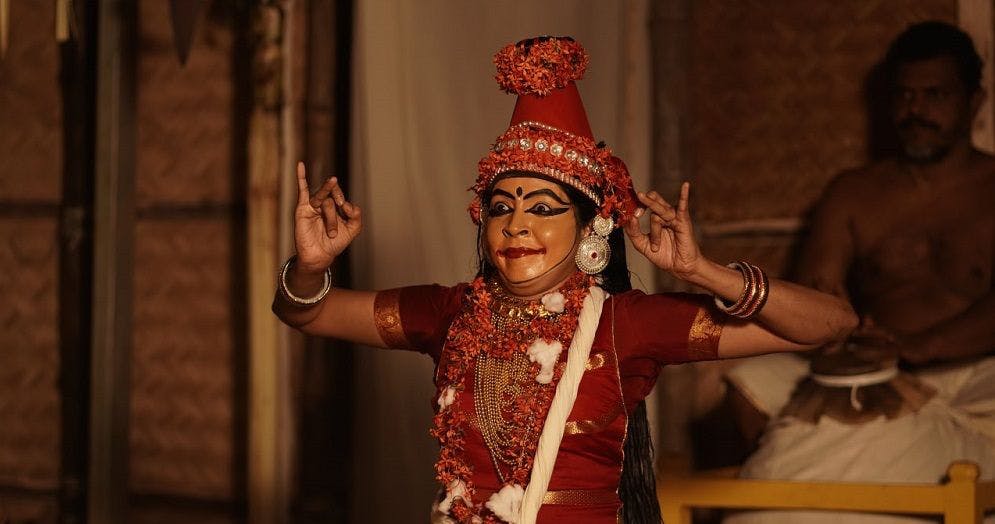Dr Aparna Nangiar has made history again by presenting Dasamam Koothu for the second time over a gap of seven years. This time it was at the home of Kaimukku Raman Akkithiripad at Kodakara in Thrissur district, on August 5, 6 and 7.
Dasamam Koothu is quintessential of an art form assuming ritualistic overtones. It is presented in connection with the sanjayanam of an Akkithirippad, the title of a prelate who has conducted Athirathram, the most intricate among the Yagas. It is believed that the presentation of the Koothu would help attain moksha for the deceased and his surviving wife. Though performed in the format of Nangiarkoothu, it derives the name from the leitmotif of the performance which is the story of Krishna excerpted from the tenth skanda (chapter) of Bhagavatham, whereas, Nangiarkoothu is the nirvahanam (pre-story recital) of the chedi (maid servant) of Subhadra in the second Act of the play Subhadra Dhananjayam.
Interestingly, Dasamam Koothu provides immense opportunities for a female actor to be on a par with her male counterpart. She enacts the characters and recites slokas herself just as in a play. Further just as a male vesham in Anguiyankam can present the Ramayana samkshepam, here, after the presentation from Avatharam to Swargarohanam, a samkshepam of the Krishna story has to be staged again. Moreover, an array of stories like Rugminiswayamvaram, Syamanthakam, Narakasuravadham, Sisupalavadham, Kuchelavrutham, Santhanagopalam, Uddhavopadesam and Yadavanasham are also enacted as different from the Nangiarkoothu in vogue currently. The feat of ‘mudi akkitha’ during the denouement of the play is possible for a female actor only here. Thus one can see elements of gender equality in Dasamam Koothu.
Special costume
The aahaarya of the artist gives enough indication to prove that it is a precursor of the present-day Nangiarkoothu. The headgear is conical made of plantain bark and covered with red silk. It is decorated with chethi flower. The attractive headgear is not used as the one used here has to be burnt after the show. Absence of thol vala and udyanam makes it less attractive. The garland worn is made of chethi flower and paruthy (cotton). At the same time poinakham worn by actors in Koodiyattam is also there. The face make-up is pazhukka.
The koothu was presented in a specially constructed shamiana on the lines of a Koothambalam facing east and visible to the wife of the deceased. A bone collected during sanjayanam was placed on a tripod in front of the stage. The art from derives its name Chudala koothu thanks to the presence of the bone. Six performances spread over three days – one in the morning and another in the evening – were presented by Aparna at Kodakara. A performance at the nearby Vishnu temple was mandatory for the completion of the rituals, as ordained by tradition.
Descendants of Grithachi.
Legend has it that once, while celestial maidens were performing the play ‘Lakshmi Naarayanam’ under the supervision of Sage Bharatha, one among them, Grithachi, failed to deliver her dialogue at a particular juncture, since the soul of an Akkithirippad who had entered heaven had made her dumb. An infuriated Bharatha cursed her and sent her to earth. For the atonement of the curse, she was asked to narrate the stories of Krishna near the cremation site of an Akkithiripad. It is believed that Nangiars are descendants of Grithachi.
Aparna had staged the koothu back in 2014 at the Naduvam Mana at Naandikkara. The kramadeepika (production manual) was prepared from the granthas available in the Panthal and Kaimukku manas and also vetted by Ammannur Kuttan Chakyar, Aparna’s father. The performance assumes much importance as of now there is no reference to the staging of Dasamam koothu during the last 200 years. For the same reason, Aparna has turned a cynosure among the Koodiyattam fraternity.
At the Kodakara performance, Kalamandalam Narayanan Nambiar drummed on the mizhavu and Indira Nangiar kept rhythm. Aparna is presently an assistant professor in the Sanskrit faculty of Sree Sankara College, Kalady and an accomplished Koodiyattam artiste in the Ammannur tradition.


2 Comments
Very informative
Very informative. A detailed description on Dasamam koothu will be a new piece of valuable information to the young lot.